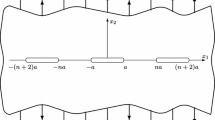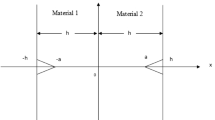Abstract
A constrained problem for a composite material with an interface crack subject to non-penetration conditions is considered. The response of a composite consisting of two identical homogeneous orthotropic materials is described with respect to in-plane deformation. The coupling of the materials occurs at an interface with angle between their vertical planes of elastic symmetry. The model is not split into independent in-plane and anti-plane states. Well-posedness of the problem is proved by variational methods. For numerical computations, a semi-smooth Newton method is proposed and its convergence is studied. Using the proposed algorithms, numerical experiments for an interface crack under mode-3 loading are presented and analyzed with respect to the half-angle defining the coupling.
Similar content being viewed by others
References
Lur’e AI (1964) Three-dimensional problems in the theory of elasticity. Interscience, New York
Cherepanov GP (1979) Mechanics of brittle fracture. McGraw-Hill, New York
Morozov NF (1984) Mathematical foundation of the crack theory. Nauka, Moscow (in Russian)
Davidson BD, Krüger R, König M (1995) Three-dimensional analysis of center-delaminated unidirectional and multidirectional single-leg bending specimens. Comp Sci Technol 54:385–394
Byron Pipes R, Pagano NJ (1970) Interlaminar stresses in composite laminates under uniform axial extension. J Comp Mater 4:538–548
Khludnev AM, Kovtunenko VA (2000) Analysis of cracks in solids. WIT-Press, Southampton Boston
Khludnev AM, Sokolowski J (1999) The Griffith formula and the Cherepanov-Rice integral for crack problems with unilateral conditions in nonsmooth domains. Eur J Appl Math 10:379–394
Ting TCT (1986) Explicit solution and invariance of the singularities at an interface crack in anisotropic composites. Int J Solids Struct 22:965–983
Nazarov SA (1998) The interface crack in anisotropic bodies: stress singularities and invariant integrals. J Appl Maths Mech 62:453–464
Mifflin R (1977) Semismooth and semiconvex functions in constrained optimization. SIAM J Control Optim 15:959–972
Klatte D, Kummer B (2002) Nonsmooth equations in optimization. Kluwer Publishers, Dordrecht
Ulbrich M (2003) Semismooth Newton methods for operator equations in function spaces. SIAM J Optim 13:805–842
Cottle RW, Pang J-S, Stone RE (1992) The linear complementarity problem. Academic Press, Boston
Hintermüller M, Kovtunenko VA, Kunisch K (2004) The primal–dual active set method for a crack problem with non- penetration. IMA J Appl Math 69:1–26
Hintermüller M, Kovtunenko VA, Kunisch K (2004) Semismooth Newton methods for a class of unilaterally constrained variational problems. Adv Math Sci Appl 14:513–535
Hintermüller M, Kovtunenko VA, Kunisch K (2005) Generalized Newton methods for crack problems with non- condition. Numer Methods Partial Differential Equations 21:586–610
Hintermüller M, Ito K, Kunisch K (2003) The primal–dual active set strategy as a semismooth Newton method. SIAM J Optim 13:865–888
Ito K, Kunisch K (2003) Semi-smooth Newton methods for the variational inequalities of the first kind. ESAIM, Math Model Numer Anal 37:41–62
Leontiev A, Herskovits J, Eboli C (1998) Optimization theory application to splitted plane bending problems. Int J Solids Struct 35:2679–2694
Belhachmi Z, Sac-Epée JM, Sokolowski J (2005) Mixed finite elements methods for smooth domain formulation of crack problems. SIAM J Numer Anal 43:1295–1320
Moës N, Dolbow J, Belytschko T (1999) A finite element method for crack growth without remeshing. Int J Numer Math Engng 46:131–150
Sukumar N, Moës N, Moran B, Belytschko T (2000) Extended finite element method for three-dimensional crack modelling. Int J Numer Math Engng 48:1549–1570
Lekhnitskii SG (1963) Theory of elasticity of an anisotropic body. Holden-Day, San Francisco
Kovtunenko VA (2006) Interface cracks in composite orthotropic materials and their delamination via global shape optimization. Optim Eng 7:173–199
Rice JR (1988) Elastic fracture mechanics concepts for interfacial cracks. Trans ASME Ser E J Appl Mech 55:98–103
König M, Krüger R, Kussmaul K, von Alberti M, Gädke M (1997) Characterizing static and fatigue interlaminar fracture behavior of a first generation graphite/epoxy composite. In: Hooper JS (ed) 13th Composite materials: testing and design 13, ASTM STP 1242, ASTM, 60–81
Hintermüller M, Kovtunenko VA, Kunisch K (2006) An optimization approach for the delamination of a composite material with non-penetration. In: Glowinski R, Zolesio J-P (eds) Free and moving boundaries: analysis, simulation and control, Lecture Notes in Pure and Applied Mathematics 252. Chapman & Hall/CRC (to appear)
Author information
Authors and Affiliations
Corresponding author
Rights and permissions
About this article
Cite this article
Hintermüller, M., Kovtunenko, V.A. & Kunisch, K. Constrained optimization for interface cracks in composite materials subject to non-penetration conditions. J Eng Math 59, 301–321 (2007). https://doi.org/10.1007/s10665-006-9113-7
Received:
Accepted:
Published:
Issue Date:
DOI: https://doi.org/10.1007/s10665-006-9113-7




